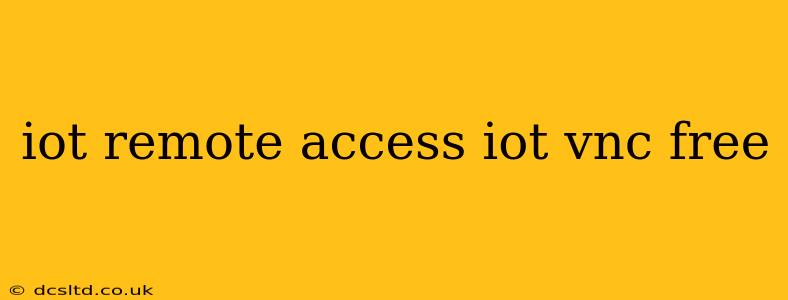The Internet of Things (IoT) has revolutionized how we interact with our devices, connecting everything from smart home appliances to industrial machinery. However, managing and troubleshooting these devices often requires remote access capabilities. This is where solutions like VNC (Virtual Network Computing) come in, enabling remote control and monitoring. While free VNC solutions exist, securing your IoT devices is paramount. This article explores free IoT remote access options, focusing on VNC and highlighting crucial security considerations. We'll also examine alternatives that prioritize security.
What is IoT Remote Access and Why is it Important?
IoT remote access allows you to connect to and control your IoT devices remotely, regardless of your physical location. This is crucial for several reasons:
- Troubleshooting: Quickly diagnose and fix issues with devices without needing on-site access.
- Management: Configure and update settings remotely, saving time and resources.
- Monitoring: Track device performance and gather data remotely.
- Control: Operate and control devices from anywhere with an internet connection.
Is Free VNC a Safe Option for IoT Remote Access?
Free VNC software offers a convenient way to access IoT devices remotely. However, relying solely on free, unsecured VNC for IoT remote access presents significant security risks. Unencrypted VNC connections are vulnerable to man-in-the-middle attacks, where malicious actors can intercept and manipulate data transmitted between your device and the IoT system.
Security Concerns with Free VNC:
- Lack of Encryption: Many free VNC clients lack robust encryption, leaving your data exposed.
- Weak Authentication: Simple passwords or default credentials can be easily compromised.
- Vulnerabilities: Outdated or poorly maintained free VNC software may contain security vulnerabilities that hackers can exploit.
Are there any Free and Secure VNC options for IoT?
While truly "free" and completely secure VNC solutions for IoT are rare, you can improve security by implementing these measures:
- Use a VPN: A Virtual Private Network (VPN) encrypts your internet traffic, adding an extra layer of security even when using free VNC.
- Strong Passwords: Employ strong, unique passwords for each device. Consider using a password manager.
- Firewall Protection: Configure firewalls on both your local network and the IoT device to restrict access.
- Regular Updates: Keep your VNC software and IoT devices updated with the latest security patches.
What are the Alternatives to Free VNC for Secure IoT Remote Access?
For enhanced security, consider these alternatives:
- SSH Tunneling: SSH (Secure Shell) provides a secure channel for remote access. It's often used to tunnel VNC traffic, adding a layer of encryption.
- Dedicated IoT Platforms: Many cloud-based IoT platforms provide built-in remote access features with strong security measures. These platforms often incorporate features like authentication, authorization, and encryption.
How can I secure my IoT devices against unauthorized access?
Beyond the choice of remote access software, several security practices are crucial for protecting your IoT devices:
- Regular Firmware Updates: Keep firmware updated to patch vulnerabilities.
- Strong Passwords and Authentication: Use strong, unique passwords and enable multi-factor authentication where possible.
- Network Segmentation: Isolate IoT devices from your main network using a separate VLAN (Virtual LAN).
- Intrusion Detection/Prevention Systems: Monitor network traffic for suspicious activity.
What are the best practices for securing IoT remote access?
- Least Privilege: Grant only necessary access to users and devices.
- Access Control Lists (ACLs): Restrict access based on IP addresses or user roles.
- Regular Security Audits: Periodically review and update your security protocols.
What are some common security threats associated with IoT remote access?
Common security threats include:
- Malware infections: Compromised devices can spread malware to other devices on the network.
- Data breaches: Sensitive data stored on IoT devices can be stolen.
- Denial-of-service attacks: Attacks can render devices unusable.
By carefully considering the security implications and employing the best practices outlined above, you can safely and effectively manage your IoT devices remotely while minimizing vulnerabilities. Remember that a balance between convenience and security is essential when choosing a remote access solution for your IoT ecosystem.
